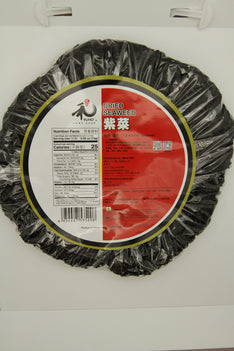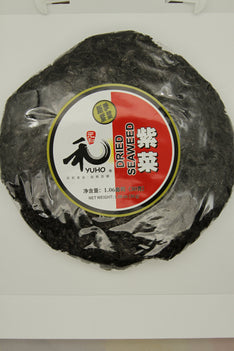Product successfully added to your shopping cart

Seaweed
More Than Just Sushi: The Deep-Rooted Love for Seaweed in Asia and Its Incredible Health Benefits
Walk through any bustling night market in Taipei, slurp a bowl of miso soup in Tokyo, or unwrap a classic Korean gimbap, and you'll encounter a ubiquitous, umami-rich ingredient: seaweed. For centuries, seaweed has been a cornerstone of Asian cuisines, far beyond its modern association with sushi. This love affair is not merely a matter of taste; it is a deep-rooted cultural tradition backed by a powerhouse of health benefits that modern science is only now fully appreciating.
A Love Forged by Geography and History
The affinity for seaweed in Asia is, first and foremost, a story of geography and necessity. With vast coastlines, seas teeming with life, and often mountainous interiors, many Asian communities looked to the ocean as a vital source of sustenance. Seaweed was a readily available, abundant, and nutritious food source that could be foraged, cultivated, and preserved with relative ease.
In Japan, records of seaweed consumption date back over 1,500 years. It was so valued that it was used as a tribute to the imperial court. Similarly, in Korea, gim (the roasted and salted sheets of seaweed) has been a staple for centuries, providing essential nutrients during harsh winters. In China, seaweed has been documented in medicinal texts for millennia, prized for its ability to treat ailments like goiter.
This historical reliance evolved into a profound cultural integration. Seaweed is not just food; it's woven into the fabric of life. It’s a symbol of celebration in Japan, where it is traditionally eaten on happy occasions, and a essential component of the foundational dashi broth that forms the soul of Japanese cooking.
The Umami Engine
Beyond history, the love for seaweed is a sensory one. Seaweed is nature's ultimate source of umami, the savory fifth taste. This deep, satisfying flavor comes from glutamates, which are naturally present in high concentrations in seaweeds like kombu. This umami quality doesn't just make seaweed delicious on its own; it acts as a flavor amplifier, enhancing the taste of other ingredients in a dish, making broths richer and more complex without the need for excessive salt or fat.
The Health Bounty from the Sea: Why Seaweed is a Superfood
The ancient communities who foraged for seaweed were onto something extraordinary. Modern nutritional science has confirmed that seaweed is one of the most nutrient-dense foods on the planet. Here’s why it’s considered a true superfood:
1. A Mineral Powerhouse
Seaweed acts like a sponge, absorbing a concentrated array of minerals from the ocean. It is famously one of the best natural sources of iodine, a critical nutrient for thyroid health, which regulates metabolism, growth, and energy levels. It's also rich in:
-
Calcium: Often higher per gram than milk, crucial for bone health.
-
Iron: Essential for oxygen transport in the blood.
-
Magnesium: Involved in hundreds of biochemical reactions in the body.
2. Packed with Vitamins
Seaweed contains a spectrum of vitamins, including Vitamin K (for blood clotting and bone health), folate (crucial for cell division), and a unique plant source of Vitamin B12, making it particularly important for vegetarians and vegans.
3. Rich in Antioxidants
Seaweeds like nori and wakame contain antioxidants such as fucoxanthin (which gives brown seaweed its color) and vitamins C and E. These compounds help combat oxidative stress and inflammation in the body, potentially reducing the risk of chronic diseases.
4. A Source of Unique Fibers
Seaweed is an excellent source of soluble fiber, but its standout components are alginate, carrageenan, and agar. These fibers are prebiotics, meaning they feed the beneficial bacteria in your gut. Furthermore, they can swell in the stomach, promoting feelings of fullness and aiding in weight management.
5. Heart and Metabolic Health
Studies suggest that the compounds in seaweed can help support heart health by reducing blood pressure and cholesterol levels. The fiber helps bind to bile acids in the gut, which the body then excretes, forcing it to use up cholesterol to create more.
A Taste of the Sea in Every Bite: Popular Seaweeds
-
Nori: The most familiar, used to wrap sushi and onigiri. It's typically sold in thin, dried sheets and is packed with protein and vitamins.
-
Kombu: The king of umami, used to make dashi broth. It’s a key ingredient in simmered dishes and is prized for its high mineral content.
-
Wakame: Known for its tender texture and mild sweetness, it's the star in miso soup and seaweed salads.
-
Dulse: With a soft, chewy texture and a smoky, bacon-like flavor when fried, it's a popular snack.
A Legacy for the World
The Asian love for seaweed is a testament to a harmonious relationship with the natural environment—a wisdom that recognized a nutritional goldmine in the ocean's gardens. Today, as the world searches for sustainable, nutrient-rich foods to feed a growing population, seaweed stands out as a powerful solution. It requires no fresh water, no fertilizer, and actively improves water quality as it grows.
So, the next time you enjoy a crisp piece of gim, a warming bowl of miso soup, or a beautifully crafted sushi roll, remember that you are partaking in a centuries-old tradition—one that nourishes the body and delights the palate with the profound, savory taste of the sea.


